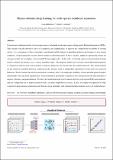Physics-informed deep learning for multi-species membrane separations
Author(s)
Rehman, Danyal; Lienhard, John H.
DownloadAccepted version (3.932Mb)
Open Access Policy
Open Access Policy
Creative Commons Attribution-Noncommercial-Share Alike
Terms of use
Metadata
Show full item recordAbstract
Conventional continuum models for ion transport across polyamide membranes require solving partial differential equations (PDEs). These models typically introduce a host of assumptions and simplifications to improve the computational tractability of existing solvers. As a consequence of these constraints, conventional models struggle to generalize predictive performance to new unseen conditions. Deep learning has recently shown promise in alleviating many of these concerns, making it a promising avenue for surrogate models that can replace conventional PDE-based approaches. In this work, we develop a physics-informed deep learning model to predict ion transport across diverse membrane types. The proposed architecture leverages neural differential equations in conjunction with classical closure models as inductive biases directly encoded into the neural framework. The neural methods are pre-trained on simulated data from continuum models and fine-tuned on independent experiments to learn multi-ionic rejection behaviour. We also harness the attention mechanism, commonly observed in language modelling, to learn and infer key paired transport relationships. Gaussian noise augmentations from experimental uncertainty estimates are also introduced into the measured data to improve robustness and generalization. We study the neural framework’s performance relative to conventional PDE-based methods, and also compare the use of hard/soft inductive bias constraints on prediction accuracy. Lastly, we compare our approach to other competitive deep learning architectures and illustrate strong agreement with experimental measurements across all studied datasets.
Date issued
2024-04Department
Rohsenow Kendall Heat Transfer Laboratory (Massachusetts Institute of Technology); Massachusetts Institute of Technology. Department of Mechanical EngineeringJournal
Chemical Engineering Journal
Publisher
Elsevier BV
Citation
Rehman, Danyal and Lienhard, John H. 2024. "Physics-informed deep learning for multi-species membrane separations." Chemical Engineering Journal, 485.
Version: Author's final manuscript
ISSN
1385-8947